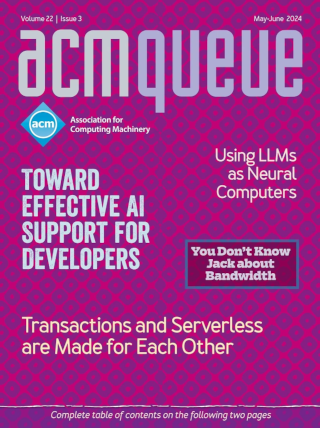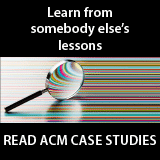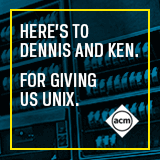A Bigot by Any Other Name...:
Are you an Open Source Bigot?
I’ve been responsible for hiring many software engineers. I tend to ask lots of elaborate technical questions so I can really get to know how the candidate thinks and works with me while solving hard problems. QA engineers will appreciate this one (it’s a “negative test” for intellectual honesty): “Explain the relative strengths and weaknesses of FreeBSD, Windows NT, Solaris, and Linux.”
A Chance Gardener:
Harvesting open-source products and planting the next crop
It is a very natural progression for a company to go from being a pure consumer of open source, to interacting with the project via patch submission, and then becoming a direct contributor. No one would expect a company to be a direct contributor to all the open-source projects it consumes, as most companies consume far more software than they would ever produce, which is the bounty of the open-source garden. It ought to be the goal of every company consuming open source to contribute something back, however, so that its garden continues to bear fruit, instead of rotting vegetables.
A Conversation with Chris DiBona:
Chris DiBona has been out front and outspoken about the open source movement.
He was hooked from the moment he installed Linux on an old PC when he was a teenager.
A Conversation with Cory Doctorow and Hal Stern:
Considering the open source approach
For years, the software industry has used open source, community-based methods of developing and improving software—in many cases offering products for free. Other industries, such as publishing and music, are just beginning to embrace more liberal approaches to copyright and intellectual property. This month Queue is delighted to have a representative from each of these camps join us for a discussion of what’s behind some of these trends, as well as hot-topic issues such as identity management, privacy, and trust.
A Conversation with David Anderson:
Supercomputing on the grassroots level
Millions of PCs on desktops at home helping to solve some of the world’s most compute-intensive scientific problems. And it’s an all-volunteer force of PC users, who, with very little effort, can contribute much-needed PC muscle to the scientific and academic communities.
A Conversation with Sam Leffler:
A Unix and BSD pioneer discusses the open source movement.
The seeds of Unix and open source were sown in the 1970s, and Sam Leffler was right in there doing some of the heaviest cultivating. He has been actively working with Unix since 1976 when he first encountered it at Case Western Reserve University, and he has been involved with what people now think of as open source, as he says, “long before it was even termed open source.” While working for the Computer Systems Research Group (CSRG) at the University of California at Berkeley, he helped with the 4.1BSD release and was responsible for the release of 4.2BSD.
Beyond the Repository:
Best practices for open source ecosystems researchers
Much of the existing research about open source elects to study software repositories instead of ecosystems. An open source repository most often refers to the artifacts recorded in a version control system and occasionally includes interactions around the repository itself. An open source ecosystem refers to a collection of repositories, the community, their interactions, incentives, behavioral norms, and culture. The decentralized nature of open source makes holistic analysis of the ecosystem an arduous task, with communities and identities intersecting in organic and evolving ways. Despite these complexities, the increased scrutiny on software security and supply chains makes it of the utmost importance to take an ecosystem-based approach when performing research about open source.
Closed Source Fights Back:
SCO vs. The World-What Were They Thinking?
In May 2003, the SCO Group, a vendor of the Linux operating system, sent a letter to its customers. Among other things, it stated, "We believe that Linux is, in material part, an unauthorized derivative of Unix." What would make SCO do that?
Commercializing Open Source Software:
Many have tried, a few are succeeding, but challenges abound.
The use of open source software has become increasingly popular in production environments, as well as in research and software development. One obvious attraction is the low cost of acquisition. Commercial software has a higher initial cost, though it usually has advantages such as support and training. A number of business models designed by users and vendors combine open source and commercial software; they use open source as much as possible, adding commercial software as needed.
Desktop Linux: Where Art Thou?:
Catching up, meeting new challenges, moving ahead
Linux on the desktop has come a long way - and it’s been a roller-coaster ride. At the height of the dot-com boom, around the time of Red Hat’s initial public offering, people expected Linux to take off on the desktop in short order. A few years later, after the stock market crash and the failure of a couple of high-profile Linux companies, pundits were quick to proclaim the stillborn death of Linux on the desktop.
Eclipse: A Platform Becomes an Open-Source Woodstock:
Call it a platform. Call it a tool. Call it the hottest open-source software movement since Linux.
All those descriptions currently surround Eclipse, the language-agnostic code base that’s billed as a “universal platform.” According to its creators it’s more precisely a metaplatform. That is, it’s a building tool out of which developers can create IDEs, or indeed anything else they might desire.
Free and Open Source Software - and Other Market Failures:
Open source is not a goal as much as a means to an end.
Open source was not so much the goal itself as a means to an end, which is freedom: freedom to fix broken things, freedom from people who thought they could clutch the source code tightly and wield our ignorance of it as a weapon to force us all to pay for and run Windows Vista. But the FOSS movement has won what it wanted, and no matter how much oldsters dream about their glorious days as young revolutionaries, it is not coming back, because the frustrations and anger of IT in 2024 are entirely different from those of 1991.
From Server Room to Living Room:
How open source and TiVo became a perfect match
The open source movement, exemplified by the growing acceptance of Linux, is finding its way not only into corporate environments but also into a home near you. For some time now, high-end applications such as software development, computer-aided design and manufacturing, and heavy computational applications have been implemented using Linux and generic PC hardware.
Is Open Source Right for You?:
A fictional case study of open source in a commercial software shop
The media often present open source software as a direct competitor to commercial software. This depiction, usually pitting David (Linux) against Goliath (Microsoft), makes for fun reading in the weekend paper. However, it mostly misses the point of what open source means to a development organization. In this article, I use the experiences of GizmoSoft (a fictitious software company) to present some perspectives on the impact of open source software usage in a software development shop.
It Takes a Community:
The Open-source Challenge
Of the many challenges faced by open-source developers, among the most daunting are some that other programmers scarcely ever think about. Building a successful open-source community depends on many different elements, some of which are familiar to any developer. Just as important are the skills to recruit, to inspire, to mentor, to manage, and to mediate disputes. But what exactly does it take to pull all that off?
KV the Loudmouth:
A koder with attitude, KV answers your questions. Miss Manners he ain’t.
What requirement is being satisfied by having Unclear build a P2P file-sharing system? Based upon the answer, it may be more effective, and perhaps even more secure, to use an existing open source project or purchase commercial software to address the business need.
OSS Supply-chain Security: What Will It Take?
While enterprise security teams naturally tend to turn their focus primarily to direct attacks on their own infrastructure, cybercrime exploits now are increasingly aimed at easier targets upstream. This has led to a perfect storm, since virtually all significant codebase repositories at this point include at least some amount of open-source software. But opportunities also abound there for the authors of malware. The broader cybercrime world, meanwhile, has noted that open-source supply chains are generally easy to penetrate. What's being done at this point to address the apparent risks?
Open Source to the Core:
Using open source in real-world software products: The good, the bad and the ugly
The open source development model is not exactly new. Individual engineers have been using open source as a collaborative development methodology for decades. Now that it has come to the attention of upper and middle management, however, it’s finally being openly acknowledged as a commercial engineering force-multiplier and important option for avoiding significant software development costs.
Open-source Firmware:
Step into the world behind the kernel.
Open-source firmware can help bring computing to a more secure place by making the actions of firmware more visible and less likely to do harm. This article’s goal is to make readers feel empowered to demand more from vendors who can help drive this change.
Opening up the Baseboard Management Controller:
If the CPU is the brain of the board, the BMC is the brain stem.
In 2011 Facebook announced the Open Compute Project to form a community around open-source designs and specifications for data center hardware. Since then, the project has expanded to all aspects of the open data center. This column focuses on the BMC and is an introduction to a complicated topic. The intention is to provide a full picture of the world of the open-source BMC ecosystem, starting with a brief overview of the BMC’s role in a system, touching on security concerns around the BMC, and then diving into some of the projects that have developed in the open-source ecosystem.
Queue Portrait: Robert Watson:
Queue’s Kode Vicious interviews Robert Watson, a security researcher and open source developer at the University of Cambridge about a project studying the boundaries of the hardware/software interface.
Robert Watson is a security researcher and open source developer at the University of Cambridge looking at the hardware-software interface. He talks to us about spanning industry and academia, the importance of open source in software research, and challenges facing research that spans traditional boundaries in computer science. We also learn a bit about CPU security, and why applications, rather than operating systems, are increasingly the focus of security research. What are the challenges in the evolving hardware-software interface? Could open source hardware provide a platform for hardware-software research? And why is current hardware part of the problem?
Software Drift:
Open source forking
Since the systems have a common parent, they probably work in the same technical domain, and therefore the features and fixes that are going to be added are probably similar. KV happens to have an example case at hand: two operating systems that diverged before they added SMP (symmetric multiprocessing) support. When an operating system adds SMP to an existing kernel, the first thing we think of is locks, those handy-dandy little performance killers that we've all been sprinkling around our code since the end of Dennard scaling.
The Age of Corporate Open Source Enlightenment:
Like it or not, zealots and heretics are finding common ground in the open source holy war.
It’s a bad idea, mixing politics and religion. Conventional wisdom tells us to keep them separate - and to discuss neither at a dinner party. The same has been said about the world of software. When it comes to mixing the open source church with the proprietary state (or is it the other way around?), only one rule applies: Don’t do it.
The Expense of Unprotected Free Software:
It's high time FOSS maintainers got a bit of appreciation
Until the big guns manage to sort things out, we're just going to need to take care of things however we can. The best we can hope for, of course, is to convince companies, institutions, and governments that it would be a really good idea to cut monthly checks for those people who maintain the software that these organizations absolutely depend upon.
The Non-psychopath's Guide to Managing an Open-source Project:
Respect your staff, learn from others, and know when to let go.
Transitioning from one of the technical faithful to one of the hated PHBs (pointy-haired bosses), whether in the corporate or the open-source world, is truly a difficult transition. Unless you are a type who has always been meant for the C-suite?, it's going to take a lot of work and a lot of patience, mostly with yourself, to make this transition.
There’s No Such Thing as a Free (Software) Lunch:
What every developer should know about open source licensing
The licenses for most software are designed to take away your freedom to share and change it. By contrast, the GNU General Public License is intended to guarantee your freedom to share and change free software to make sure the software is free for all its users. So begins the GNU General Public License, or GPL, which has become the most widely used of open source software licenses. Freedom is the watchword; it’s no coincidence that the organization that wrote the GPL is called the Free Software Foundation and that open source developers everywhere proclaim, “Information wants to be free.”
Thread Scheduling in FreeBSD 5.2:
To help get a better handle on thread scheduling, we take a look at how FreeBSD 5.2 handles it.
A busy system makes thousands of scheduling decisions per second, so the speed with which scheduling decisions are made is critical to the performance of the system as a whole. This article - excerpted from the forthcoming book, “The Design and Implementation of the FreeBSD Operating System“ - uses the example of the open source FreeBSD system to help us understand thread scheduling. The original FreeBSD scheduler was designed in the 1980s for large uniprocessor systems. Although it continues to work well in that environment today, the new ULE scheduler was designed specifically to optimize multiprocessor and multithread environments. This article first studies the original FreeBSD scheduler, then describes the new ULE scheduler.
Three-part Harmony for Program Managers Who Just Don't Get It, Yet:
Open-source software, open standards, and agile software development
This article examines three tools in the system acquisitions toolbox that can work to expedite development and procurement while mitigating programmatic risk: OSS, open standards, and the Agile/Scrum software development processes are all powerful additions to the DoD acquisition program management toolbox.
Viewing Open Source with an Open Mind:
Most writing about open source stresses the goodness (or lack of goodness) of open source as a software development model.
Some of the more interesting articles discussing open source have been from the economic point of view. Since the dismal science of economics sees nothing as purely good or bad, these types of pieces generally make for interesting reading, in turn leading you to think a bit more carefully about the possibility that open source might be good for some things but less good for others.






